 4
4

Examining the pyramid with the mions
 19. 04. 2024
19. 04. 2024



 4
4

 19. 04. 2024
19. 04. 2024

 1
1

 17. 04. 2024
17. 04. 2024
 6
6

 16. 04. 2024
16. 04. 2024
 3
3
 09. 03. 2023
09. 03. 2023

Margit Slimáková (* 1969), is an expert in health prevention and nutrition. She studied pharmacy and dietetics and uses proven knowledge from all areas of medicine. She has lived and worked in Germany, China, France and the USA. He publishes books and articles, lectures, organizes seminars and promotes healthy nutrition in schools.
Here is a list of the most important questions for a doctor before vaccination:
Vaccination: hypotheses versus facts
According to medical and pharmaceutical organizations, the decline in infectious diseases is clearly caused by vaccination, while we are assured of its safety and effectiveness. And despite the fact that the allegations are in clear contradiction with government statistics, published medical studies, and FDA reports (Food and Drug Administration) and CDC (Centers for Disease Control).
Actually:
Natural decline in infectious diseases
According to vaccine advocates, we owe vaccine vaccines for liquidation or at least a drastic decrease in the number of infectious diseases. We have repeatedly suggested that our ancient ancestors have been massively dying of terrifying infectious diseases, that we should be grateful for the vaccination, and that any tiny health problems associated with vaccination are many times offset by its enormous benefits. In fact, however, the official statistical data of various countries clearly show that the most significant decrease in the number of infectious diseases occurred especially in the first half of the twentieth century, and thus before the introduction of nationwide vaccination programs.
Below are examples of graphs from different countries that confirm my position. I prefer to respond directly to a possible counter-argument that they are purposefully manipulated by quoting a study from the prestigious medical journal JAMA (Journal of the American Medical Association), where the fact is very concisely formulated.
The study "Infectious disease mortality trends during the 20th century in the USA" states that:
For those who are surprised that vaccination is not even mentioned here, I explain that it is completely neglected, because it was not widely introduced until the second half of the twentieth century. Personally, I'm also pleased with the use of the word probably, because no one really knows for sure what factors led to these declines. This is despite claims by pharmaceutical and medical proponents that the positive effect of vaccination is quite certain and unquestionable. I also present copies of several graphs compiled on the basis of statistical data from different countries. These and similar charts are commonly available on the Internet, often on the websites of organizations that promote free choice in vaccination, and in books on similar topics. It is absolutely essential that the graphically represented information is supported by the text of the above-cited medical study.
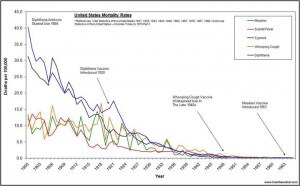 A chart of measles, spleen, abdominal typhoid, black cough, and diphtheria in the United States. In this case, the decline in vaccination-related morbidity should be followed by a whooping cough with widespread use. The terms started use and introduced means only limited vaccination, the effect of which is virtually impossible to judge. I consider the most interesting to follow the drops in mortality in the typhoid and scarlet fewer, which were never flattened.
A chart of measles, spleen, abdominal typhoid, black cough, and diphtheria in the United States. In this case, the decline in vaccination-related morbidity should be followed by a whooping cough with widespread use. The terms started use and introduced means only limited vaccination, the effect of which is virtually impossible to judge. I consider the most interesting to follow the drops in mortality in the typhoid and scarlet fewer, which were never flattened.
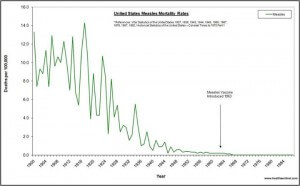 In a more detailed submission, the decline in measles mortality in the United States.
In a more detailed submission, the decline in measles mortality in the United States.
[clearboth]

Decreases in measles, spleen, black cough, and diphtheria in England and Wales. Even here there was no vaccination against measles, and vaccination against measles, black cough, and diphtheria came at a time when it was hard to cope.

a) More detailed graphs showing the relationship between drop in mortality and measles vaccination and black cough in England and Wales. Data gap means the absence of information from a given period, and therefore a break of the curve.
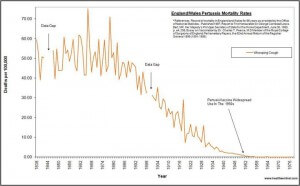
b) More detailed graphs showing the relationship between drop in mortality and measles vaccination and black cough in England and Wales. Data gap means the absence of information from a given period, and therefore a break of the curve.
The graphs below are based on official data on death rates recorded in the Central Yearbook of the Commonwealth of Australia and are taken from Greg Beattie's book "Vaccination of Parental Dilemma." The graphs represent a decrease in infectious disease mortality in Australia and clearly show that vaccination has nothing to do with mortality.
The leading causes of death among children between 1911 and 1935 in Australia were infectious diseases, diphtheria, whooping cough, measles and measles. By 1945, when mass vaccination programs had not yet been introduced, combined mortality from these causes had fallen by as much as 95%. The author further states that graphical evidence of declining infectious disease mortality in the United States, England, New Zealand, and many other countries shows exactly the same trend.
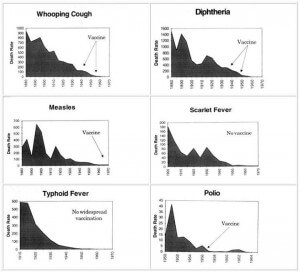 Again, I find it very interesting to observe that the drastic decline in mortality has occurred in infectious diseases that are not vaccinated, as well as those that we have been fanatically vaccinated for decades. [clearboth]
Again, I find it very interesting to observe that the drastic decline in mortality has occurred in infectious diseases that are not vaccinated, as well as those that we have been fanatically vaccinated for decades. [clearboth]
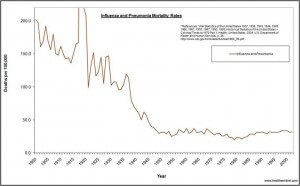
Another chart shows the flu-like mortality curve and inflammatory lung disease in the US during the twentieth century. The first flu vaccination was given there during the Second World War and the number of influenza vaccinations increased significantly around 1990. As is correctly stated on the web: "The lack of value of the vaccine is shown in a nutshell."
Risks of vaccination
The U.S. Vaccine Adverse Events Reporting System (VAERS) receives about XNUMX reports of serious vaccine adverse events each year, including one to two hundred deaths and several times the number of permanent disabilities. Despite the fact that these numbers are already alarming, this is just the tip of the iceberg, because:
The pharmaceutical and medical industries like to throw anyone who starts questioning the set vaccination calendar or just asks for its individualization with regard to the health status of their own children in the bag of opponents of vaccination. They are often described as uneducated, unable to understand modern scientific knowledge or just lazy parents. At the same time, the vast majority of parents who require the opportunity to decide on vaccinating their children have quite above-average knowledge, because they are often actively interested in vaccinations, often studying from independent and foreign sources. The second large group are the parents of children who have already been damaged by vaccination, who are therefore cautious about vaccination. A typical example is a father who went to a doctor's office with a two-month-old infant to be vaccinated:
"At the time my son was due to receive the first recommended vaccinations, I had no idea of any serious risks associated with these vaccinations, but I learned in a leaflet in the office waiting room that DTP vaccinations were associated with the risk of serious side effects that would occur. in one in 1750 children, while the chance that my child will die of whooping cough is one in many millions. ”
In December 2010, a study comparing the health status of vaccinated and unvaccinated children was launched in Germany. The study is still ongoing, here are the first interim results:
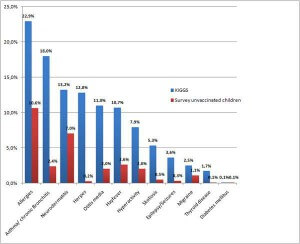 In the last fifty years, no large-scale study comparing the health of vaccinated and unvaccinated individuals has been conducted in the United States by any government organization such as the CDC. At the same time, the number of vaccinations required is growing, with the number of sick children. Currently, up to half of American children suffer from some of the chronic diseases, and 21% are diagnosed with developmental disabilities. Below is a graph showing the dramatically increasing number of autistic children in the United States. Modern medicine cannot explain this trend, but according to doctors, it certainly has nothing to do with vaccination! Vaccine manufacturers and their providers are surprisingly sure of this.
In the last fifty years, no large-scale study comparing the health of vaccinated and unvaccinated individuals has been conducted in the United States by any government organization such as the CDC. At the same time, the number of vaccinations required is growing, with the number of sick children. Currently, up to half of American children suffer from some of the chronic diseases, and 21% are diagnosed with developmental disabilities. Below is a graph showing the dramatically increasing number of autistic children in the United States. Modern medicine cannot explain this trend, but according to doctors, it certainly has nothing to do with vaccination! Vaccine manufacturers and their providers are surprisingly sure of this.
What is the main argument of pharmacists, why is it impossible to carry out a study comparing seated and non-inoculated children? Because vaccines are such a wonderful life-saving medicine, it is not possible to give them to the baby. They ignore the fact that there are thousands of non-inoculated children in groups that gather around, for example, about alternative education or some religion.
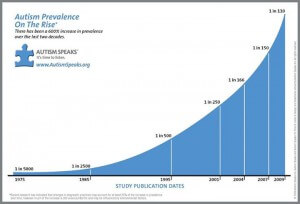 Another extremely interesting medical study is the work that examined the relationship between the number of compulsory vaccinations and infant mortality in several dozen countries.
Another extremely interesting medical study is the work that examined the relationship between the number of compulsory vaccinations and infant mortality in several dozen countries.
The study "Infant mortality increases with the number of routine vaccinations" states that:
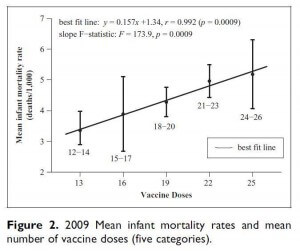 The chart shows five groups of countries according to the number of vaccinations prescribed for their children and the number of infant deaths in these countries.
The chart shows five groups of countries according to the number of vaccinations prescribed for their children and the number of infant deaths in these countries.
Arguments for vaccination
Individuals and organizations demanding free choice in vaccination point to vaccination risks, increased morbidity in children, unproven efficacy and safety of vaccines, lack of interest in monitoring long-term consequences after vaccination, inability to compensate for vaccine damage, especially parents' responsibility for their own children's health. Of course, this responsibility is also linked to the right to decide on medical procedures performed on children.
What are the arguments of vaccination advocates? The constant repetition of the mantra that vaccination saved us. Furthermore, it is mostly argued the need to ensure collective protection, often also by the uneducatedness of parents who want to decide on professional issues that they do not understand.
I would like to quote here from the just completed Slovak study "Collective immunity - myths and facts." Part of a study already published describes in detail the possibilities, or rather the impossibility, of providing collective immunity for vaccination against tuberculosis, diphtheria, tetanus and pertussis. According to the study, there is no evidence in the vaccines described that they protect against the spread of disease, and most of them cannot even have such properties in principle.
The thesis also asks a logical question: How is it possible that in neighboring countries (for example in Germany and Austria), where the movement of foreigners is significantly higher, vaccination is not necessary to maintain public health? By simply crossing the border to us, would unvaccinated individuals endanger public health? The study concludes with the argument that if vaccination works, vaccinated individuals have nothing to fear, and if it does not work reliably, it is not permissible to force anyone to do so.
Individuals with serious weakened immunity are threatened daily by the most common infections, not the diseases it is vaccinated against. Moreover, this argument presupposes the functioning of the principle of collective immunity, which has not been proven by independent studies; I myself have just questioned the principle of collective immunity by quoting one of the studies.
Official medicine is not interested in monitoring the health status of vaccinated and unvaccinated children. Independent studies clearly confirm higher morbidity in vaccinated children. The above study looking at the relationship between vaccination rates and infant mortality across countries found a clear link between higher compulsory vaccinations and higher infant mortality.
I consider it essentialto clarify that so-called opponents of vaccination only demand the right to decide on the health of their children, in no case do they order anyone else to behave. Logically, therefore, they do not even want anyone else (and certainly not the parties earning the vaccination) to decide what medical procedures their child must undergo. Opponents of vaccination are easily refuted by the fact that there are many professionals, including those with a medical background, among activists who demand free choice in vaccination. I myself am a pharmacist by education and I cite The International Medical Council on Vaccination as an example of a medical organization that refuses compulsory vaccination. It is an association of physicians, registered nurses and other qualified health professionals who oppose the claims of pharmaceutical companies, the government and medical organizations. Among other things, this association considers vaccination to be an unacceptable risk for everyone, does not recognize the theory of collective immunity and demands that the right to refuse vaccination be enshrined in the constitution.
In addition, there are a number of books currently in the market that have been written by doctors who also call for abolition of the practice of vaccination enforcement, as well as objective studies on the efficacy and risks of vaccination.